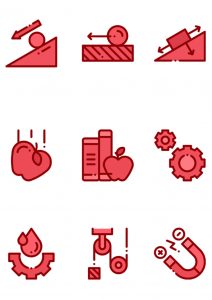Advantages and Disadvantages of Friction: The force acting between two surfaces is known as friction. It is an opposition that exists between two moving things resisting each other’s motion.
Friction is necessary for providing traction, which allows for easier movement. Friction is used by all automobiles to accelerate, slow down, and even change course. Friction is what allows us to do things like a stroll to your favourite bookshop or stack kitchenware on another, but it also has several drawbacks. Friction is an unavoidable phenomenon and you can’t spend a day without experiencing it.

Let’s look at some of the benefits and drawbacks of friction.
Recommended: Advantages and Disadvantages of shopping online
Advantages of Friction (Merits)
1. Ability to Walk: Walking is such a regular activity that few people give it a second thought. When a person walks, a static frictional force acts. You can walk without slipping thanks to frictional force.
As you walk, your foot pushes against the floor, and you would slide backwards if the frictional force was not present. Friction forces your foot towards the direction you’re trying to travel, assisting you in moving ahead.

You’ve probably observed how difficult it is to walk on ice, damp, or muddy surfaces, and how easily you may slip if you’re not cautious. The reason for this is cause the frictional force between the surface and our feet is lower.
2. Piling of Objects: Stacking items on top of one other is a fantastic technique to store items without taking up too much room on the ground. But have you ever wondered how objects manage to stay on top of one another without collapsing?
There is a friction force operating between the surfaces of the two items, which prevents the objects from sliding and so enables piling. You can’t picture keeping every dish you own lined up independently, yet friction allows you to do so.
Also see: How to become a successful lawyer
3. Stopping Of Moving Vehicles: The frictional force is what causes moving vehicles to come to a halt. When you apply brakes to a car, the friction slows it down and finally brings it to a stop. It is typical to drive to work, the movies, and the grocery store. If you’ve ever ridden or driven a car, you’re well aware of the importance of brakes. Braking in a car either reduces or stops the vehicle’s speed.
When you press the brakes on your automobile, the brake pads make contact with the brake discs, resulting in a frictional force between the discs and pads. Friction also creates heat energy and opposes the motion of the wheels, lowering the velocity to a lower value or zero, slowing or stopping the vehicle.
4. Lights up a Fire: Fire was first introduced to humans by friction in prehistoric days. Dry wooden branches or stones were rubbed together to make fire. Heat is produced by rubbing two items together.

Even now, we ignite a fire with a matchstick by rubbing the tip of the matchstick on the red stripe on the matchbox’s side. Rubbing causes friction, which produces heat, which sets off a chain of processes that eventually result in fire.
Recommended: Meaning and Differences between veins and arteries
5. Transfer of Energy: Frictional force allows energy to be transferred between two things. Friction between two moving elements of a machine aids in the transmission of energy, which is necessary for the machine’s correct operation. The pieces will slip if there is no frictional force, and energy transmission will be inefficient.
6. Writing: Writing is a very widespread activity. When using a pencil, pen, or chalk to write on paper or a board, frictional force aids you. When viewed with the naked eye, the rough surface of paper or a board seems smooth.
Friction is created when we slide the tip of a pen or pencil against the rough surface of paper or board. Because of the friction, lead particles from the pencil tip become trapped on the board or paper, which we view as writing. When writing with a pen, the situation is similar. The ink particle adheres to the paper’s rough surface.
We can’t write with our ordinary pens and pencils if the friction is very low or non-existent.
Also see: Differences between drama, poetry and prose
7. Wear Accessories: Caps, rings, and belts are examples of accessories that we wear. Any accessory that you wear must stick to you to stay on your body. The frictional force allows it to be done without the use of adhesives. They will slide off if there is no friction between the cap or ring and your body.
Glasses are worn by those who have poor vision. Because of the frictional force, the glasses stay on top of your nose.
8. Gripping on to Things: You take various items with you every time you leave the house, such as your keys and phone wallets. Friction allows you to hold all of these items in your hands.
Imagine waking up one day and discovering that you are unable to grasp objects and that they are constantly sliding from your grasp. Frictional force happens between your hands and the item when you hold anything in your hand, preventing it from slipping.
Also see: How to read and understand effectively
9. Generating Heat: Heat is produced by the frictional force between two surfaces. This phenomenon is employed in a variety of equipment that needs heating, such as a spin welding machine. When we are chilly, we frequently rub our hands together. The friction created by rubbing palms creates heat, which enables our hands to warm up.
Recommended: Best science courses to study in the university
Disadvantages of Friction (demerits)
1. Loss of Energy: Energy cannot be lost; it is constantly changing to different forms. Friction is an example of this. Heat is produced by the frictional force between two bodies. The two moving bodies have kinetic energy, and part of it is converted into heat energy. It causes a loss of kinetic energy, which causes the objects’ motion to decelerate considerably.
2. Resists Motion: When two items rub against each other, frictional force is created. The resistance to motion between two objects is known as frictional force. It functions in the opposite direction of movement, making it harder to slide things off of one other. Regardless of how heavy an object is, if there is no friction sliding off, it will not need much labour.
Also see: Most difficult courses to study in the world
3. Moving Machinery Parts’ Life is Reduced: Moving parts of machines have a shorter lifespan due to frictional forces. When two machine parts are continually rubbing against each other, the parts might soon wear out.
4. Overheating: Heat is produced by friction between two surfaces. Machines with moving components are subjected to friction, and using them for extended periods can result in overheating. Overheating equipment parts wastes energy and puts the machine in danger of damage.
5. Forest Fires: Forest fires are a natural occurrence that results in substantial animal and plantation devastation. It also raises carbon emissions, which contributes to global warming.
Forest fires are most often triggered by natural causes. A high-velocity wind sweeps through the trees and plantations, forcing the tree branches to scrape against each other. It creates friction between them, which produces heat and finally ignites.
Also see: How to control your emotional intelligence
6. Wear and Tear: Constant friction causes object wear and tear, reducing its lifespan dramatically. Things that wear out will need to be replaced, which adds to the financial expense. Objects would not wear out as quickly if there was no frictional force operating on them.
7. Decreased Efficiency: Machine efficiency is reduced as a result of frictional force. The efficiency of a machine is determined by its ability to convert energy efficiently.
Friction converts mechanical energy to heat, which cannot be transferred back to mechanical energy, resulting in waste. Objects wear and tear as a result of the continual friction. Friction causes an increase in energy consumption.
Also see: How to know a person with low intelligence
8. Excessive Noise Production: If not oiled correctly, moving mechanical pieces, such as a door on a hinge, cause needless noise. When two rough surfaces scrape against each other, noise is produced. Friction causes this noise, which contributes to noise pollution.
Recommended: Advantages and Disadvantages of a written constitution
Conclusion
Even our day-to-day tasks require frictional power to be completed. Friction is required for basic functions such as walking, writing, and even grasping objects. Friction, on the other hand, causes machine and other item wear and tear.

Edeh Samuel Chukwuemeka, ACMC, is a lawyer and a certified mediator/conciliator in Nigeria. He is also a developer with knowledge in various programming languages. Samuel is determined to leverage his skills in technology, SEO, and legal practice to revolutionize the legal profession worldwide by creating web and mobile applications that simplify legal research. Sam is also passionate about educating and providing valuable information to people.
